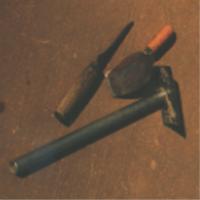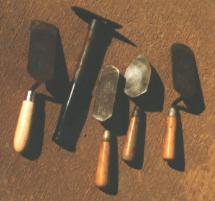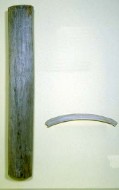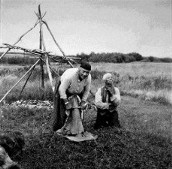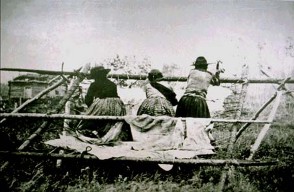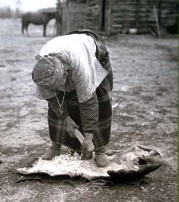|
First,
I want to Thank everyone for understanding about my computer problems.
My husband had to replace our motherboard and a few other parts
in our computer.
I had
an appointment to speak with a friend of my husband about tanning
hides however a week before we were to meet his wife called to
inform us he had passed on from a heart attack. I felt
lost at that point.
I tried
to contact another man via email because he also is a tanner and
has some great articles on his web site about the history and
tanning but he never e-mailed me back so I am attempting do this
article myself. So here we go.....
|
| |
| Preparing a Hide
for Clothing |
|
I
was only going to do this article just on Brain Tanning but decided
to do two articles starting from after the hide is removed from
the animal to the finished product.
This
first Article will deal with two of the processes that are done
to a hide and the tools that are used, Fleshing and De-Hairing
a hide. The next article will deal with Brain Tanning-Dry Scraping
and Wet Scraping, Stretching a hide and Smoking.
From
prehistoric times to the present, one of the ways people all over
the world have clothed themselves is with animal skins. Before
making the clothing, the hides had to go though several processes
to soften and make them pliable. Around the world people use different
methods of achieving this.
There
is are some excellent sites that talk of the history of brain
tanning. I have put the links below under History. I have found
these articles very interesting to read. There are also some excellent
books on the market which I have also listed below plus a video.
|
| |
| What is Fleshing? |
| Fleshing removes the membranes, fat, meat, and
other tissues from the hide. It is best done while the hide is still
fresh, after it is thawed from being frozen or if the hide has been
re-hydrated after it has been dried. |
| |
| How is it done? |
|
The tools used in fleshing are a knife, and a hoe like tool.
In the past they were made from the bones or antler of an animal
with a piece of metal or flat stone attached to them. Today tanners
use knifes at different angles, cement trowels, a piece of flexible
box strapping and a small hand hoe-one used for a garden tool.
Below are some picture of tools from the past as well as present
day tools.
|
|
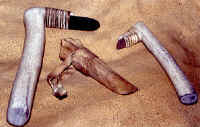
The
pictures on the left and right are fleshing tools.
The middle one is a scraper
http://www.braintan.com/intro/wetdry2.htm
|
Modern fleshing tools
www.healingearth.com/btan/start.html
|
| |
| What is De-Hairing
the hide? |
|
De-hairing depends on the project you have planned for the
hide. If you are making a pouch you may want to leave on the hair
however if you want to use the hide to make clothing you want
to take the hair off.
|
| |
| How is this process
done? |
|
There are two ways to de-hair a hide.
One way is to soak the hide in water for several days until
the bacteria that builds up loosening and separating the epidermis
layers and the hair. After this occurs it is then stretched onto
a frame or laid over a beaming log. Scraping tools are used against
the grain of the hair to remove it.
The other way is to take wood ash lye and spread it all over
the hair side of the hide. Then it is rolled up, hair side in,
and tied. After 4-5 days it is unrolled to see if the hair will
pull out easily. If not a little more wood ash lye can be added
and then it will be rolled up again and checked every few days.
When the hair is easy to pull out a scraper is used against the
grain of the hair to remove it.
Below are some pictures on past scraping tools used and tools
that are used in the present.
|
|
Past Scraping tools
www2.sd81.bc.ca/~fnap/moose/moosetools.html
|
Some of the Modern Scraping
Tools
www.healingearth.com/btan/start.html
|
|
|
|
|
Beaming Log and Beaming Scraper
http://collections.ic.ga.ca/artic/luxton/sect_3/3d8.htm
|
Cree Woman from Canada working
on beaming log with her hide
http://collections.ic.ga.ca/artic/luxton/sect_3/3d7.htm
|
|
|
|
|
Three Stoney Women on the
Morley Reserve in Canada scraping a hide
http://collections.ic.ga.ca/artic/luxton/sect_3/3d5.htm
|
Woman Scraping a hide.
http://collections.ic.ga.ca/artic/luxton/sect_3/3d12.htm
|
| |
| The other processes of Tanning to be continued
in the next issue. |
| |
| Related
Links: |
|
|


